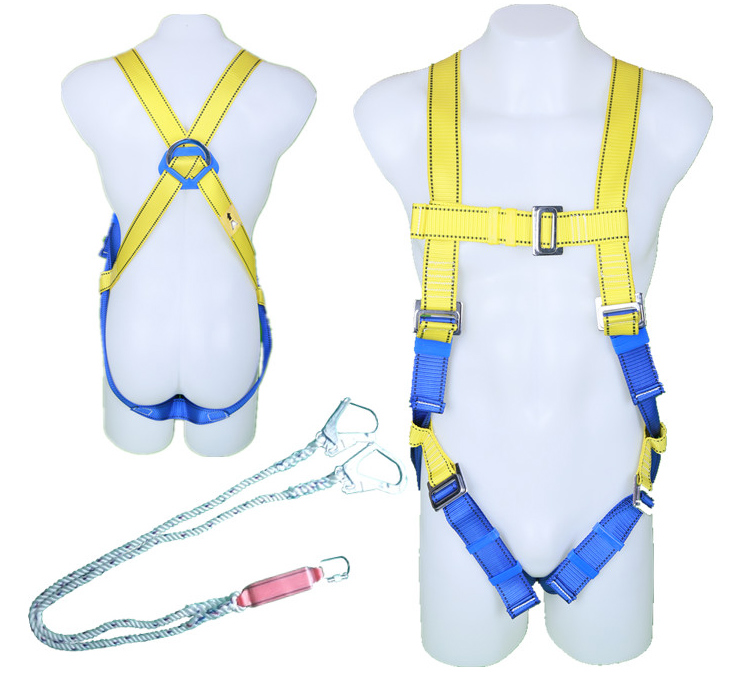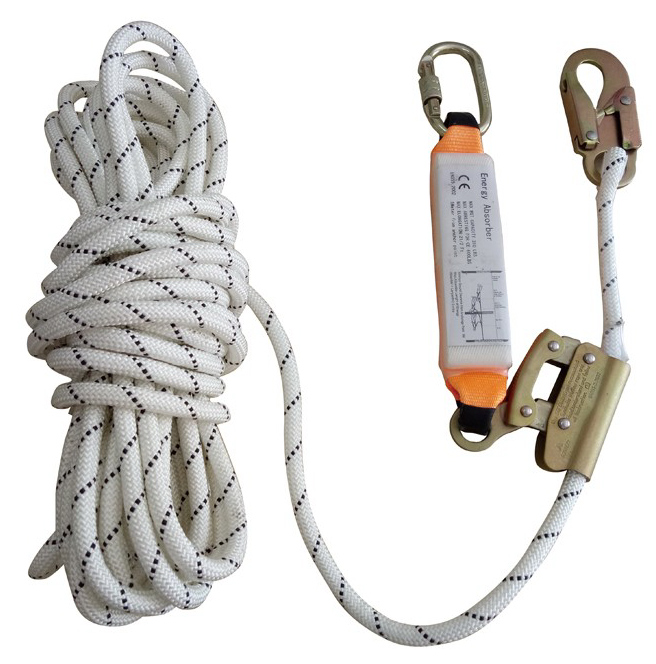Why use safety harness correctly
(1) Why use safety harness
The safety harness can effectively avoid the huge damage to the human body caused by the fall in the event of an accident. According to the statistical analysis of fall accidents from heights, fall accidents from heights above 5m account for about 20%, and those below 5m account for about 80%. The former is mostly fatal accidents, it seems that 20% only accounts for a small part of the data, but once it happens, it may take 100% of a life.
Studies have found that when falling people accidentally fall to the ground, most of them land in a supine or prone position. At the same time, the maximum impact force that a person's abdomen (waist) can withstand is relatively large compared to the entire body. This has become an important basis for the use of safety harness.
(2) Why use safety harness correctly
When an accident occurs, a fall will produce a huge downward force. This force is often much greater than the weight of a person. If the fastening point is not strong enough, it will not be able to prevent the fall.
Most of the fall accidents are sudden accidents, and there is no time for installers and guardians to take more measures.
If the safety harness is used incorrectly, the role of the safety harness is equivalent to zero.

Photo: Item no. YR-QS017A
How to use safety harness for working at heights correctly?
1. Basic working at heights safety precaution tools
(1) Two 10-meter long safety ropes
(2) safety harness
(3) strapping rope
(4) a protective and lifting rope
2. Common and correct fastening points for safety ropes
Tie the safety rope to a firm place and place the other end on the working surface.
Commonly used fastening points and fastening methods:
(1) Fire hydrants in corridors. Fastening method: Pass the safety rope around the fire hydrant and fasten it.
(2) On the handrail of the corridor. Fastening method: Firstly, check whether the handrail is firm and strong, secondly, pass the long rope around the two points of the handrail, and finally pull the long rope forcefully to test whether it is firm.
(3) When the above two conditions are not met, put a heavy object on one end of the long rope and place it outside the customer's anti-theft door. At the same time, lock the anti-theft door and remind the customer not to open the anti-theft door to prevent loss of security. (Note: The anti-theft door may be opened by the customer, and it is generally not recommended to use).
(4) When the anti-theft door cannot be locked due to frequent entry and exit of the customer's home, but the anti-theft door has a firm double-sided handle, it can be bolted to the anti-theft door handle. Fastening method: The long rope can be looped around the handles on both sides and fastened firmly.
(5) The wall between the door and the window can be selected as the buckle body.
(6) Large wooden furniture in other rooms can also be used as the object of the buckle selection, but it should be noted that: do not choose the furniture in this room, and do not connect directly through the window.
(7) other fastening points, etc. Key points: The buckle point should be far away rather than close, and relatively strong objects such as fire hydrants, corridor handrails, and anti-theft doors are the first choice.
3. How to wear safety harness
(1) The safety harness is well fitting
(2) correct buckle insurance buckle
(3) Tie the buckle of the safety rope to the circle on the back of the safety belt. Tie the safety rope to jam the buckle.
(4) The guardian pulls the buckle end of the safety harness on his hand and supervises the work of the outdoor worker.
(2) Why use safety harness correctly
When an accident occurs, a fall will produce a huge downward force. This force is often much greater than the weight of a person. If the fastening point is not strong enough, it will not be able to prevent the fall.
Most of the fall accidents are sudden accidents, and there is no time for installers and guardians to take more measures.
If the safety harness is used incorrectly, the role of the safety harness is equivalent to zero.


4. Places and methods for banning the buckling of safety ropes and safety harness
(1) Hand-drawn method. It is strictly forbidden for the guardian to use the hand-hand method as the buckle point of the safety harness and safety belt.
(2) The method of tying people. It is strictly forbidden to use the method of tethering people as a protection method for air-conditioning at heights.
(3) Air-conditioning brackets and unstable and easily deformable objects. It is strictly forbidden to use the outside air conditioner bracket and unstable and easily deformable objects as the fastening points of the seat belt.
(4) Objects with sharp edges and corners. In order to prevent the safety rope from being worn and broken, it is strictly forbidden to use sharp-edged objects as the buckle points of the safety harness and safety belt.

Photo: Item no. YR-GLY001
5. Ten guidelines for the use and maintenance of safety harness and safety blet
(1). The role of safety harness must be emphasized ideologically. Countless examples have proved that safety blet are "life-saving belts". However, a few people find it troublesome to fasten a safety harness and it is inconvenient to walk up and down, especially for some small and temporary tasks, and think that "the time and work for the safety harness are all done." As everyone knows, the accident happened in an instant, so safety belts must be worn in accordance with regulations when working at heights.
(2). Check whether all parts are intact before use.
(3). If there is no fixed hanging place for high places, steel wire ropes of appropriate strength should be used or other methods should be adopted for hanging. It is forbidden to hang it on moving or with sharp corners or loose objects.
(4). Hang high and use low. Hang the safety rope at a high place, and people working underneath are called high-hanging low-use. It can reduce the actual impact distance when a fall occurs, on the contrary it is used for low hanging and high. Because when a fall occurs, the actual impact distance will increase, and people and ropes will be subject to a greater impact load, so the safety harness must be hung high and used low to prevent low-hanging high use.
(5). The safety rope should be tied to a firm member or object, to prevent swinging or collision, the rope cannot be knotted, and the hook should be hung on the connecting ring.
(6. The safety belt rope protective cover should be kept intact to prevent the rope from being worn out. If the protective cover is found to be damaged or detached, a new cover must be added before use.
(7). It is strictly forbidden to extend and use the safety harness without authorization. If a long rope of 3m and above is used, a buffer must be added, and the components must not be arbitrarily removed.
(8). After using the safety belt , pay attention to maintenance and storage. To check the sewing part and hook part of the safety harness frequently, it is necessary to check in detail whether the twisted thread is broken or damaged.
(9). When the safety harness is not in use, it should be kept properly. It should not be exposed to high temperature, open flame, strong acid, strong alkali or sharp objects, and should not be stored in a damp warehouse.
(10). Safety belts should be inspected once after two years of use. Frequent visual inspections should be performed for frequent use, and abnormalities must be replaced immediately. safety harness s that have been used in regular or sampling tests are not allowed to continue to be used.
Post time: Mar-31-2021
